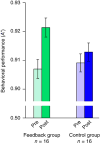Closed-loop training of attention with real-time brain imaging
- PMID: 25664913
- PMCID: PMC4503600
- DOI: 10.1038/nn.3940
Closed-loop training of attention with real-time brain imaging
Abstract
Lapses of attention can have negative consequences, including accidents and lost productivity. Here we used closed-loop neurofeedback to improve sustained attention abilities and reduce the frequency of lapses. During a sustained attention task, the focus of attention was monitored in real time with multivariate pattern analysis of whole-brain neuroimaging data. When indicators of an attentional lapse were detected in the brain, we gave human participants feedback by making the task more difficult. Behavioral performance improved after one training session, relative to control participants who received feedback from other participants' brains. This improvement was largest when feedback carried information from a frontoparietal attention network. A neural consequence of training was that the basal ganglia and ventral temporal cortex came to represent attentional states more distinctively. These findings suggest that attentional failures do not reflect an upper limit on cognitive potential and that attention can be trained with appropriate feedback about neural signals.
Figures





Comment in
-
Attention: feedback focuses a wandering mind.Nat Neurosci. 2015 Mar;18(3):327-8. doi: 10.1038/nn.3962. Nat Neurosci. 2015. PMID: 25710832 Free PMC article.
-
Closed-loop cognition: the next frontier arrives.Trends Cogn Sci. 2015 May;19(5):242-3. doi: 10.1016/j.tics.2015.03.008. Epub 2015 Mar 25. Trends Cogn Sci. 2015. PMID: 25818939 Free PMC article.
References
-
- Chun MM, Golomb JD, Turk-Browne NB. A taxonomy of external and internal attention. Annu Rev Psychol. 2011;62:73–101. - PubMed
-
- Mackworth NH. The breakdown of vigilance during prolonged visual search. Q J Exp Psychol. 1948;1:6–21.
-
- Redelmeier DA, Tibshirani RJ. Association between cellular-telephone calls and motor vehicle collisions. N Engl J Med. 1997;336:453–458. - PubMed
-
- Czeisler CA, et al. Modafinil for excessive sleepiness associated with shift-work sleep disorder. N Engl J Med. 2005;353:476–486. - PubMed
-
- Dinges DF, Powell JW. Microcomputer analyses of performance on a portable, simple visual RT task during sustained operations. Behav Res Methods Instrum Comput. 1985;17:652–655.
Publication types
MeSH terms
Substances
Grants and funding
LinkOut - more resources
Full Text Sources
Other Literature Sources

